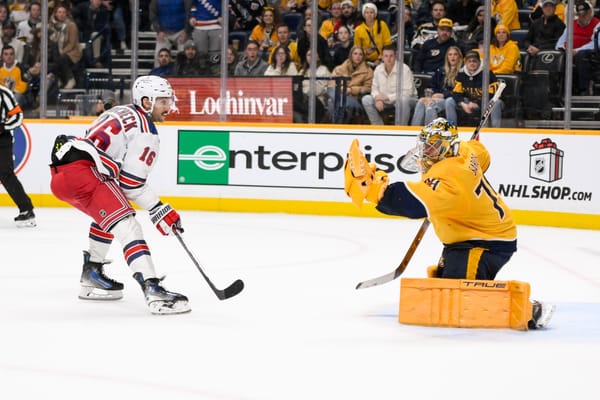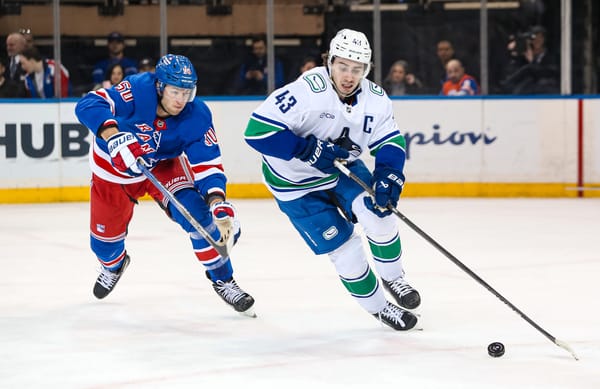The Importance Of Evidence-Based Arguments
When I graduated from Quinnipiac University, I did so with a journalism degree; I wanted to be a sports broadcaster. When it was clear those jobs simply weren’t for the taking – or required moves across the country – I settled for being a sports writer. I had my own blog about the Rangers on Wordpress, had recently joined Blueshirt Banter as a writer, and enjoyed what I was doing.
After a few months of post-college unemployment, I got a job as a sportswriter for a local paper in New Britain, Connecticut. I spent a year and a half there, learned a few things, and saw a world that I simply wasn’t willing to invest the prime years of my life in (for reasons that we don’t have to get into here).
That said, the grind was real on the high school beat. Days would be spent in musky high school hallways fighting with admission parents at the front door trying to prove I was a reporter and didn’t need to pay to get in (we never got business cards). Once that was settled, I would find a seat that gave me the best view of the respective field of play (anything played on a football field had a press box, which was nice, everything else was with general admission), and keep track of statistics on a notepad by hand. Then I’d go to the coach and a few kids to grab quotes, churn out a story from my car in freezing cold parking lots if I had another game to go to that night, or head back to the office to write the story, then put the paper together.
Often times you’d run into your counterparts from other papers. Towns that had a particularly big school would have their own local papers or magazines to cover the team from an even more local level. No matter how local we tried to get, more often than not, team stats in the aggregate page were the only way kids saw their names in the paper.
One day I was talking to a friendly counterpart who was much older than I who had a cup of coffee as a reporter for a bigger publication that covered professional teams. As much as we were competitors, there was camaraderie that came with sharing a press box with someone who put up with the same crap you did day after day. (Note: Stories were never negative about kids – as it should be, since they’re kids – but parents were often furious if they didn’t think their kid was mentioned enough or the team’s coverage has been spotty. That was never fun. You were also blamed for all negative comments thrown into the comment section of said story. Also not fun. And once parents knew who you were, they’d try to sit near you to loudly talk about how good their kid is, or try to get you to write more about them. Yeah). As we were talking, he mentioned how the business had changed. With social media, even high school sports had fans able to dissect stories from angles that were never possible before. He lamented how nice it was to be, as he put it, “the law” when it came to stories – that what he wrote was the truth and nothing but the truth, because when people picked up the paper in the morning that was their only connection to what they were consuming. And even if people did disagree, outside of letters to the editor, there was no other way to voice your complaints.
I tell you this because it’s not hard to see the comparison to today’s media. I have no illusions that this website and other blogs are a source of frustration to the men and women who have lived through this dramatic change in the sports journalism landscape. Even so much as ten years ago, a blurb written in a story might be taken as a fact, and that fact might have existed forever. Why? Simply because there was no way to disprove it or even highlight it. Before Twitter and Facebook, there was nothing with this volume of eyeballs ready to consume information.
If a beat reporter wrote, “Player X, who has been a disaster in his own end all year, continued the trend with yet another horrid performance Tuesday,” it would eventually take hold, simply because there was no way to really disagree with him/her. See it enough and it becomes second nature, and then fact. Boom. That easy.
Oh sure, you might watch the games and disagree, but enough people form opinions over time based on what they’re repeatedly told (which is normal). Those reputations would often follow players even after they left the team or were traded on because reporters often lean on each other for information and it stuck. As an example, I remember Nik Zherdev as an offensively talented player who was atrocious in his own zone; I wonder what his career in New York would have looked like today. I wonder how I would have viewed him today with the benefit of advanced stats and more information. I have a funny feeling I would have liked him a lot more than I already did.
These days, it’s simply not as easy – if Player X is bad, then why not show evidence to support such things? Where in the past the above paragraph would have simply been accepted, it’s now being questioned.
I can point to current examples, but we’ve been through them enough times. Here’s a great example from three years ago, when I came to the defense of Keith Yandle and Dan Boyle from their continued undeserving roasting from the media:
Here’s where I think analytics play an enormous role in painting a picture of what your eyes are telling you: At even strength Girardi has given the puck away 10 times, is a -71 in shot differential and has been on the ice for seven even strength goals against. Yandle has given the puck away 12 times (more than Girardi has) but is a +19 in shot differential and has only been on the ice for three even strength goals against. Zone starts play into Girardi’s numbers being a little lower, but has Yandle really been that bad? Have his turnovers really hurt the Rangers that much?
What about this article from two years ago where I needed to come to the aid of Henrik Lundqvist, who was being discussed as part of the “problem” for the Rangers?
Yes, Lundqvist has been average this year. There’s no way around it. His save percentage and his goals against average are both 17th out of 29 goaltenders who played in 15 games or more this year. Those are not the numbers we’ve come to expect from him, and it’s clear this team has relied on him to clean up their mess for too long ...
Lundqvist, despite his struggles, has by no means been a disaster. His 82.9 high danger save percentage is 11th out of 50 goaltenders who have played at least 500 minutes this year 5v5. Yes, he’s given up five low danger goals so far (he gave up six all of last year for full disclosure) but he’s also been screened, hung out to dry and worn down more games than not. His .912 save percentage might look awful (for him) but he’s had a .920+ in 11 of his 20 games this year.
Or this one on the same subject just a few months later, where Shayna provided even more data and analysis on why Lundqvist wasn’t putting up the numbers he always had.
Of the 40 defensive pairs that played at least 50 minutes of 5v5 in the postseason, the combination of McDonagh and Girardi were on the ice for the most shot attempts against (221). With McDonagh and Girardi in front of him, Lundqvist faced 100 shots against – which was the third highest number of shots against a defensive combination in the playoffs. Additionally, that pair faced the most scoring chances against than any other pair in the playoffs. And that was the pair that received the most ice time in the playoffs for the Rangers (198.62 minutes of 5v5).
The combination of Staal and Holden had the worst shots against per 60 (31.94) of the Rangers’ defensive combinations. But they were the pair that was deployed in front of Lundqvist in the most critical moments of a number of games, (remember Game 2 against Montreal? All of the Canadiens’ goals in regulation were scored with Holden and Staal on the ice, yet when the Rangers had a one-goal lead in the final minute, that pair was deployed – again showing how the coaching impeded on Lundqvist and the Rangers).
Of the shots Lundqvist faced, 156 were low-danger shots. He only allowed two low-danger goals in the playoffs, which resulted in a 0.987 low-danger save percentage. Additionally, Lundqvist faced 90 medium danger shots (the third most).
Articles like this, data like this, and the ability to respond publicly like this were never possible before the advent of the new statistical age of sports and the explosion of social media. But there’s a level of importance here, too. Because while, yes, it’s probably annoying that people who have never been questioned before are not being questioned from all angles, it also makes the quality of coverage better, because people are being held accountable for what they write.
Hockey in particular seems to be a sport riddled with generally accepted clichés – Grit. Toughness. Determination. Intangibles. Leadership. Knowing how to win. Tough as nails. High hockey IQ. Net-front presence. Clutch. Chemistry – all of these based on things you can’t see.
In the past, these cliches have been sprinkled or heaped onto stories because they seemed like things you needed to be in the room to know. Without anyone to contradict them with evidence-based facts, they were presented as opinions, but taken as truths. It’s the way the business worked. But recent evidence has proven that those words more often than not mean nothing, especially used the way they are.
In this space we’ve been remarkably critical of specific aspects of this team. Alain Vigneault. Dan Girardi. Tanner Glass. They take the top three spots easily. But when presenting reasons why we feel the way we did/do, it’s presented with evidence. It doesn’t always have to be statistical, either – we’ve run countless video-based stories to try and articulate our points and feelings.
When we run these stories, the criticism comes back at us with the fury of the above. You’re not in the room. You don’t know hockey. Oh, so you’re smarter than an NHL head coach? Typical blogger. He does things you can’t measure with stats, moron. Corsi doesn’t tell you how a player makes his teammates feel safe. Enforcers help make space for top line players. Toughness wins games in the playoffs. Regardless of the reaction, the point was made with a backing. You might disagree with it, but it was there, and it was dense.
Evidence provided to combat this is usually met with more of “you don’t know hockey” or “you’re not as smart as an NHL coach,” but that’s not the point. If the insinuation is that people in positions of power can’t be questioned simply because they’re in positions of power, then what’s the point of life – especially when someone is showing you hard evidence that says otherwise. You can, of course, disagree about the importance analytics plays in the NHL, but it’s become crystal clear that the eye test simply doesn’t work on its own.
The point of all this? I feel as though the dynamic of the blogging world in relation to the journalism world is changing. Years ago bloggers could be ignored, but these days they have their own viewing interests as results. This space, specifically, has grown to levels I never thought possible.
That said, rather than looking at us as “rebels” or “people who stir the pot” or “panic inducers,” perhaps realize that we’re simply looking at the world of hockey through a different lens. Reporters and blogs with a voice do have a responsibility to provide as much evidence as they can when making claims. Those who are “in the room” have a responsibility to tell it how it is and hold those who they talk to accountable. Interactions don’t have to turn into an interrogation, but there’s no place in 2018 for complacency. You can always default to your own eye test, but you have to at least mention the other side of the coin as well. If you want to argue that Glass is an effective player because of his ability to bring toughness to the ice, you need to at least admit that he also hurts other aspects of the team. You can still have the opinion he’s worth it as a player, but you have to provide evidence for both sides of the coin.
Because if you don’t, someone else will.





